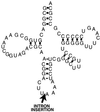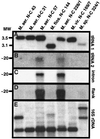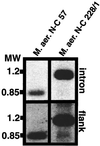Nested evolution of a tRNA(Leu)(UAA) group I intron by both horizontal intron transfer and recombination of the entire tRNA locus
- PMID: 11790735
- PMCID: PMC139512
- DOI: 10.1128/JB.184.3.666-671.2002
Nested evolution of a tRNA(Leu)(UAA) group I intron by both horizontal intron transfer and recombination of the entire tRNA locus
Abstract
The origin and evolution of bacterial introns are still controversial issues. Here we present data on the distribution and evolution of a recently discovered divergent tRNA(Leu)(UAA) intron. The intron shows a higher sequence affiliation with introns in tRNA(Ile)(CAU) and tRNA(Arg)(CCU) genes in alpha- and beta-proteobacteria, respectively, than with other cyanobacterial tRNA(Leu)(UAA) group I introns. The divergent tRNA(Leu)(UAA) intron is sporadically distributed both within the Nostoc and the Microcystis radiations. The complete tRNA gene, including flanking regions and intron from Microcystis aeruginosa strain NIVA-CYA 57, was sequenced in order to elucidate the evolutionary pattern of this intron. Phylogenetic reconstruction gave statistical evidence for different phylogenies for the intron and exon sequences, supporting an evolutionary model involving horizontal intron transfer. The distribution of the tRNA gene, its flanking regions, and the introns were addressed by Southern hybridization and PCR amplification. The tRNA gene, including the flanking regions, were absent in the intronless stains but present in the intron-containing strains. This suggests that the sporadic distribution of this intron within the Microcystis genus cannot be attributed to intron mobility but rather to an instability of the entire tRNA(Leu)(UAA) intron-containing genome region. Taken together, the complete data set for the evolution of this intron can best be explained by a model involving a nested evolution of the intron, i.e., wherein the intron has been transferred horizontally (probably through a single or a few events) to a tRNA(Leu)(UAA) gene which is located within a unstable genome region.
Figures







Similar articles
-
Cyanobacterial tRNA(Leu)(UAA) group I introns have polyphyletic origin.FEMS Microbiol Lett. 1997 Nov 15;156(2):293-8. doi: 10.1016/s0378-1097(97)00446-1. FEMS Microbiol Lett. 1997. PMID: 9513279
-
Origin and evolution of group I introns in cyanobacterial tRNA genes.J Bacteriol. 1997 Nov;179(21):6798-806. doi: 10.1128/jb.179.21.6798-6806.1997. J Bacteriol. 1997. PMID: 9352932 Free PMC article.
-
Complex evolutionary patterns of tRNA Leu(UAA) group I introns in the cyanobacterial radiation [corrected].J Bacteriol. 1999 Jun;181(11):3445-51. doi: 10.1128/JB.181.11.3445-3451.1999. J Bacteriol. 1999. PMID: 10348857 Free PMC article.
-
Analysis of evolution of exon-intron structure of eukaryotic genes.Brief Bioinform. 2005 Jun;6(2):118-34. doi: 10.1093/bib/6.2.118. Brief Bioinform. 2005. PMID: 15975222 Review.
-
tRNA gene diversity in the three domains of life.Front Genet. 2014 May 26;5:142. doi: 10.3389/fgene.2014.00142. eCollection 2014. Front Genet. 2014. PMID: 24904642 Free PMC article. Review.
Cited by
-
The eukaryotic cell originated in the integration and redistribution of hyperstructures from communities of prokaryotic cells based on molecular complementarity.Int J Mol Sci. 2009 Jun 4;10(6):2611-2632. doi: 10.3390/ijms10062611. Int J Mol Sci. 2009. PMID: 19582221 Free PMC article. Review.
-
Reconstruction of structural evolution in the trnL intron P6b loop of symbiotic Nostoc (Cyanobacteria).Curr Genet. 2012 Feb;58(1):49-58. doi: 10.1007/s00294-011-0364-0. Epub 2011 Dec 31. Curr Genet. 2012. PMID: 22210193
-
Lichen fungi have low cyanobiont selectivity in maritime Antarctica.New Phytol. 2003 Oct;160(1):177-183. doi: 10.1046/j.1469-8137.2003.00859.x. New Phytol. 2003. PMID: 33873530
-
Morphological, chemical, and genetic diversity of tropical marine cyanobacteria Lyngbya spp. and Symploca spp. (Oscillatoriales).Appl Environ Microbiol. 2004 Jun;70(6):3305-12. doi: 10.1128/AEM.70.6.3305-3312.2004. Appl Environ Microbiol. 2004. PMID: 15184125 Free PMC article.
-
Lack of phylogeographic structure in the freshwater cyanobacterium Microcystis aeruginosa suggests global dispersal.PLoS One. 2011 May 5;6(5):e19561. doi: 10.1371/journal.pone.0019561. PLoS One. 2011. PMID: 21573169 Free PMC article.
References
-
- Besendahl, A., Y. L. Qiu, J. Lee, J. D. Palmer, and D. Bhattacharya. 2000. The cyanobacterial origin and vertical transmission of the plastid tRNA(Leu) group-I intron. Curr. Genet. 37:12–23. - PubMed
-
- Bonocora, R. P., and D. A. Shub. 2001. A novel group I intron-encoded endonuclease specific for the anticodon region of tRNA fMet genes. Mol. Microbiol. 39:1299–1306. - PubMed
-
- Castenholz, R. W., and J. B. Waterbury. 1989. Group I. Cyanobacteria, p.1710–1728. In N. Pfenning and J. G. Holt (ed.), Bergey’s manual of systematic bacteriology. The Williams & Wilkins Co., Baltimore, Md.
Publication types
MeSH terms
Substances
Associated data
- Actions
LinkOut - more resources
Full Text Sources

